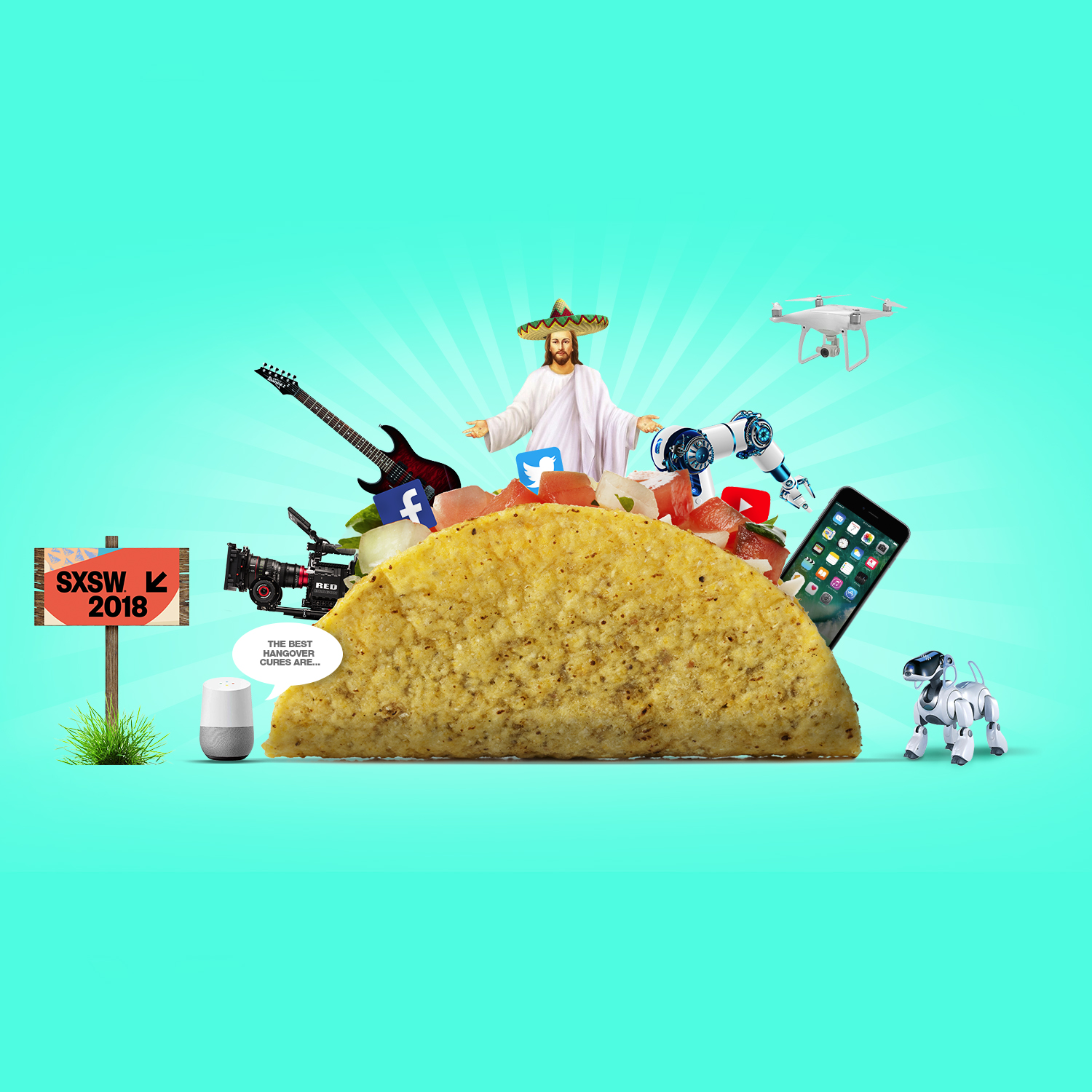Moving up the Campaign Brief Hot List
It’s the most anticipated creative ranking on the Australian advertising calendar. And ...



This was my first time in Austin, and my first impressions of the city that revels in ‘being weird’ were definitely self-affirming. On the advice of some seasoned pros, I chose to stay in East Austin and didn’t regret a second of it. There’s a bizarre, almost ‘lord of the flies’, vibe about it. Similar to what you might experience in Berlin, but completely different at the same time.
I’d often walk past old decrepit weatherboard houses adorned with rusted Americana signage realising that, in fact, there’s some kind of business in there. Big vacant blocks of land with nothing but dirt, a few benches and a couple of banged up converted trailers or vans selling tacos or BBQ. A giant bull skull assembled using mufflers and exhaust pipes looming above a mechanic/wrecker’s gate.
One house I stumbled past had a collection of tables and chairs on the patio below a weathered sign enscribed with something like ‘Jimbo’s Sports Bar’. And it was an actual bar. Imagine trying to pull that off in one of our councils. You wouldn’t last a day. I guess this must be that ‘freedom’ thing we keep hearing about.
Sometimes it almost feels like you’re wandering through a town from one of the post-apocalyptic Fallout games, such is the ramshackle nature of how the place is put together. But the charm is immediately evident. You never know what you’ll come across next. They were probably there, but I don’t actually remember seeing a 7-11.
One of the most interesting sessions I caught was Bruce Mau’s 24 Principles For Massive Change. And Bruce Mau knows a thing or two about massive change. He’s designed everything from book covers to Mecca. Yes, Mecca. Not the Mecca cosmetics store in Richmond, I’m talking Mecca the holy city. We often like to complain about being asked to make client changes to a web banner, imagine receiving feedback on your concept for the birthplace of Islam. “Make the shrine bigger.”
Everything he designs has to be done with beauty and empathy. It seems simple, but it’s incredible how often this is forgotten in the pursuit of ‘cost efficiency’ and ‘maximising return on investment’. We are magnetically drawn to things of beauty. People routinely travel to the ends of the Earth in pursuit of something beautiful. Yet we’re all feeling the pinch of a spiraling race to the bottom in terms of the production costs and value of how we express our ideas.
If it’s not captivating it’s not worth doing, and that’s something we as creators and marketers need to keep sight of. The empathy component resonated with me as a reminder to never lose sight of who you are creating for. We don’t make ads only for ourselves, we make them for everyone else. Be empathetic with your ideas.
Another poignant takeout was the reminder that we aren’t above or better than nature, we are simply part of it. And in a culture where tribalism is becoming more and more prominent, it’s important to remember that we’re all human. We all came from the same place and we’re all distant relatives. Creatives. Suits. Clients. Consumers. We often use our own labels to defend why some people don’t ‘get’ our ideas, but at the end of the day the best ideas are universally loved by all.
I’m always fascinated by listening to experts on artificial intelligence, as I can’t think of another topic so heavily spoken about that always ends at the same juncture – ‘we have no idea’.
Half are utopian, half are dystopian, and when the programmers and coders behind the movement can’t explain some of the outcomes we’re seeing, it’s easy to see why such a rift exists.
The most significant point mentioned at Exploring Innovations In AI as an indicator to the coming ‘singularity’, when artificial intelligence surpasses our own, is the development of the AlphaGo Zero program. By training AI to play a game using human inputs, the AI would eventually figure out a way to win. However, when AI was then trained by AI, it developed its own ways to win a hell of a lot quicker. Ways that humans hadn’t even considered. Scary stuff.
But fear not, Skynet is still on the distant horizon.
A good counterpoint was made to about how much data it takes for AI to learn. Even just to teach AI to recognise that a dog is a dog takes thousands and thousands of images and inputs, whereas even a two-year-old human can figure it out with relative ease. Toddlers are still more deadly than Terminators.
And here’s where we always end. Fascinating topic, but no one knows where on Earth it’s going.
Comforting isn’t it?
Beyond Ads: Become Entertainment was a great look into the alternative forms of media that brands can use to, as the title suggests, become entertainment.
The panel opened with the notion that the term ‘branded content’ often refers to long 3 or 4 minute videos when it really should be so much more.
The best example is perhaps Werner Herzog’s ‘Lo and Behold, Reveries of the Connected World’, a Sundance-winning documentary on the origins of the internet. I’ve seen this doco and didn’t even know it came out of an advertising brief for a company called Netscout.
HP created an online series called ‘The Wolf’, GE’s ‘The Message’ podcast reached #1 on the charts and Gatorade’s Matchpoint Snapchat game based on Serena William’s career was a worldwide hit.
Imagine if the brief was written with this in mind, how can we entertain people rather than advertise to them?
It’s a shift in thinking that can only do wonders for our industry.
The 6 second ad has been a thing of conjecture in adland.
It rose from the ashes of Vine and started appearing on social media platforms, but has taken a while to get right.
In the US, the 6-second spot is starting to gain traction on TV during live sport. Instead of cutting to an ad break when there’s a brief stop in play, a 6 second ad pops up on screen and delivers a message while viewers are still engaged.
What can you say in 6 seconds? Well, about as much as you can say on a billboard or a print ad.
Some of the best examples shown were basically a headline, or an insight or prop, accompanied by a quick visual.
And they worked.
Siri, Alexa, Google, there’s a huge push right now to get everyone talking to their devices. And while the experience is clunky, every single time someone around the world talks to their device, it’s learning.
I’ll admit I’m not one of them, there’s something strange about having an increasingly sentient box in my house listening to my every move, but it’s the way of the future.
And given there’s already a generation of toddlers and kids growing up with this technology, who will consider it the norm, the paranoia that resides in me will be less evident in them.
But what’s next? Gesture it seems. For certain applications, the friction of touch will be gone. We’ll just wave a hand, or raise a finger to switch a device on or off, or change the channel, or even change our environment. I played with a digital picture frame where I could alter the artwork just by waving at it. Imagine how easy it’ll be to skip an ad.
But whilst all this stuff is impressive, for a time we are going to look like massive dickheads using it.
I’ve heard certain folks talk about how data is everything. Targeting is becoming so precise that we can talk to the right person at the right time and that, advertising-wise, it guarantees us a result.
A good point was made in the ‘What’s Next After Advertising? The Jump To Content’ session, which was quite the opposite.
The more precise we get with targeting, the more important the quality of the message is.
It’s no secret that people’s appetite for advertising is waning. In a world of ad blockers and streaming services, it’s easy to avoid.
So if we start loading up our laser-guided, heat-seeking advertising data missiles with absolute shit it will have catastrophic effects on the brand.
The idea has never been more important.